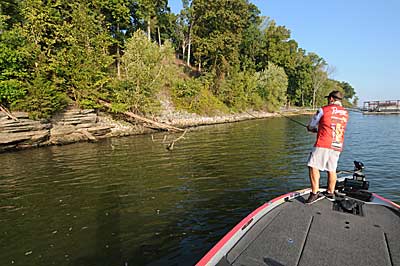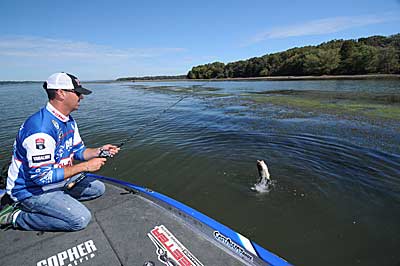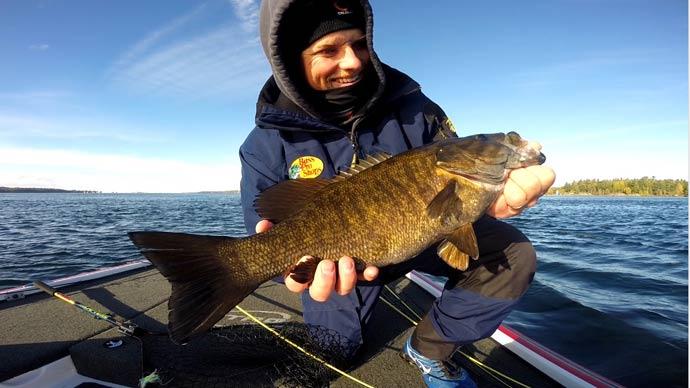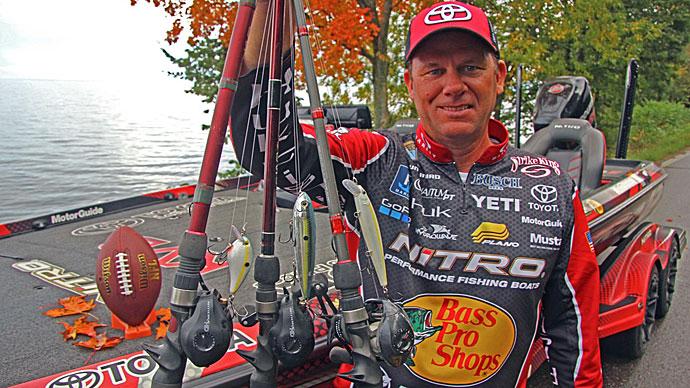
It happens every year, but what actually happens might be contrary to what some anglers have been led to believe.
When the air cools and the nights start getting longer in the fall, bass begin their annual migration to the shallows. The bass migration coincides with shad moving to the shallows. Since so many baitfish show up in the backs of creeks during this time, some anglers think bass throughout the lake have followed the shad into the creeks.
“I don’t think the fish necessarily move to the backs of creeks as many people think," says touring pro Greg Bohannon. "I think they pull up shallower on some of the points and turns just inside the creeks. Then, of course, there are always some resident fish in certain areas, but when the shad starts migrating to the mouths of the pockets or off the points into the creek arms, the bass take notice and get ready for that fall feeding.”
Major League Fishing (MLF) pro Todd Faircloth also believes a bass’ fall migration route depends on where the fish reside most of the time. “I’m not going to say that all of those fish on the main lake go to the backs of the creeks,” says Faircloth. "I think there is a population of fish that live in the major creeks, and when we start having fall, 75 percent of the fish that live in that major tributary start going to the backs of the creeks."
Falling water temperatures and decreasing daylight hours seem to trigger the fall migration for baitfish and bass. “It might be like the deer rut,” says Bohannon. “The amount of daylight that hits a deer’s retina supposedly triggers the rut but the weather always enhances that.”
Faircloth also believes both factors trigger the migration. "If you have a cold snap at that time of the year, it triggers the fish to start heading that way,” he says. “Even if you don’t get a cold snap and have a mild fall, the length of the days also plays a factor.”
The timetable and routes of the annual fall migration will vary depending on the fishery, so here is a look at when and how bass move in the fall on highland and lowland reservoirs.
Highland Reservoirs
Bohannon notices highland lake bass start changing locations when the water temperature dips into the high 70s, and the action increases as the water drops into the low 70s. “Fishing starts getting considerably better when the fish start pulling out of those summer haunts into a little more feeding activity,” he says. “I love the fall fishing. I catch a lot of big largemouth up shallow when the water temperature starts getting into the mid-70s."

Bass suspended over deep trees or drops in the 20- to 30-foot range will move into depths of 10 to 12 feet deep and start hugging the bottom in this first stage of the migration. “It seems like they are a lot easier to catch when they start that transition,” says Bohannon. He catches these fish on Carolina rigs or football jigs tipped with plastic craws and as the water continues to cool down and the fish move shallower, the Arkansas pro switches to a Super Spook or burning a spinnerbait.
During this stage, the main lake fish will move to the primary or secondary points. “Back-of-creek fish are probably resident fish, especially largemouth that don’t move out to the main lake during the summer,” says Bohannon. Bass that gang up on shad in the backs of the creeks are fish that were suspended in the timber of the creek channel.
Once the fish reach the shallows, bass remain in the thin water for the remainder of the fall. “I think they stay there a good portion of the winter until the water temperature gets down into the 40s, and then they get a little more difficult to catch,” says Bohannon, who pitches a jig and craw to shallow wood cover and boat docks to catch these fish.
When the water temperature dips into the 50s, some bass start moving back to bluffs and transition banks, so Bohannon throws Storm Lures Wiggle Wart crankbaits and swim baits until the fish move back into the deep timber and suspend in the treetops for the rest of winter.
Lowland Reservoirs
Bass migration begins on flatland reservoirs when the water temperature falls into the low 70s. Faircloth notices bass in this stage move from the main lake towards the mouths of the creeks, steep drops, secondary points, or creek channel swings. The subsequent migration phase occurs when the water temperature drops to the upper 60s and the bass move to the flats three-fourths of the way into the creeks.
During the earliest migration stage, Faircloth favors throwing a lipless crankbait that allows him to cover water quickly. Then, when the fish move to the flats, Faircloth continues throwing the lipless crankbait and tries a square-bill crankbait.
The weather determines how long bass stay on the flats. “If we have a mild fall, you can catch fish back there for a couple of months,” says Faircloth.
As the water continues to cool, bass start backing out of the creeks along the same route they followed at the fall's beginning. “They have their travel routes,” says Faircloth. “They have certain little points or spots they set up on."
When bass start moving deeper in the late fall, Faircloth tempts these fish with a deep-diving crankbait or a football jig tipped with a Yamamoto twin-tail plastic grub. The Texas pro notices that lowland bass are usually back in their wintertime haunts when the water temperature drops into the 50s.
Keeping up with bass movements in the fall can be frustrating, but you can increase your chances of success this autumn by pinpointing the bass' migration route in your favorite fishery.
BassResource may receive a portion of revenues if you make a purchase using a link above.




